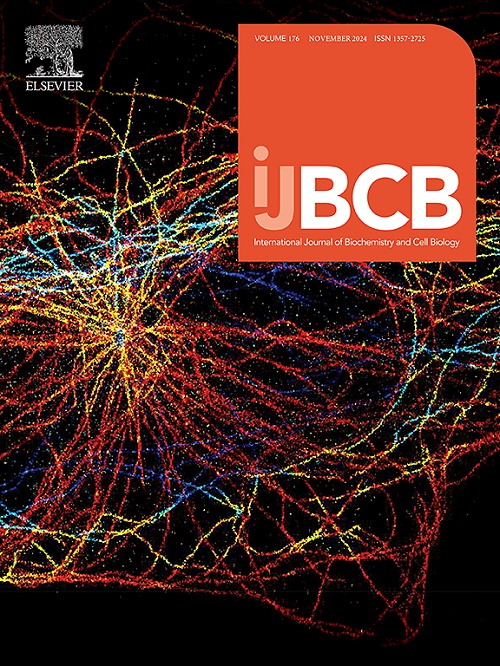Myc functions downstream of InR and their concurrent upregulation additively restricts pathogenesis of human poly(Q) disorders in Drosophila disease models
IF 2.8
3区 生物学
Q2 BIOCHEMISTRY & MOLECULAR BIOLOGY
International Journal of Biochemistry & Cell Biology
Pub Date : 2024-11-08
DOI:10.1016/j.biocel.2024.106690
引用次数: 0
Abstract
Human polyglutamine [poly(Q)] disorders are caused by abnormal expansion of CAG repeats in one gene (disease specific), yet a plethora of cellular pathways are found to be involved in their pathogenesis and progression. Despite the tremendous effort, all pursuits for the development of intervention therapy against these disorders seem futile. Recent reports suggest combination therapy as a potential strategy to combat the complex pathogenesis of such neurodegenerative disorders. The present study attempted to identify a combinatorial intervention strategy against human poly(Q) disorders in Drosophila disease models. Due to its immense potential to be stimulated by drugs, the evolutionarily conserved insulin signalling cascade which is well-established modifier of human poly(Q) pathogenesis was selected for the study. Genetic screening studies identified Drosophila Myc as a potential partner of insulin receptor (InR) that conferred additive rescue against poly(Q) induced neurodegeneration. Comprehensive analyses demonstrated InR and Myc to confer additive rescue against several events of pathogenesis, including aggregation of expanded poly(Q) containing proteins, transcriptional dysregulation, upsurge of cell death cascades, etc. Also, the synergistic rescue efficiency of InR and Myc was equally efficient in mitigating poly(Q) induced structural and functional deficits. The study also demonstrates that Myc functions downstream of InR signalling cascade to deliver rescue against human poly(Q) mediated toxicity in Drosophila disease models. In conclusion, the present study suggests that InR and Myc have the potential to be developed as a combinatorial therapeutic approach against human poly(Q) diseases.
在果蝇疾病模型中,Myc 在 InR 的下游发挥作用,它们同时上调会增加人类多聚酶(Q)紊乱的发病率。
人类多聚谷氨酰胺[多聚(Q)]紊乱症是由一个基因中 CAG 重复序列的异常扩增引起的(疾病特异性),但在其发病和发展过程中却发现有大量的细胞通路参与其中。尽管付出了巨大的努力,但针对这些疾病开发干预疗法的所有努力似乎都是徒劳的。最近的报道表明,联合疗法是应对此类神经退行性疾病复杂发病机制的一种潜在策略。本研究试图在果蝇疾病模型中找出针对人类多聚酶(Q)紊乱的组合干预策略。胰岛素信号级联是人类多聚酶(Q)致病机理中公认的调节因子,由于其具有巨大的药物刺激潜力,本研究选择了进化保守的胰岛素信号级联作为研究对象。遗传筛选研究发现,果蝇的 Myc 是胰岛素受体(InR)的潜在伙伴,能对多聚(Q)诱导的神经退行性病变产生相加拯救作用。综合分析表明,InR和Myc对多种致病事件具有相加拯救作用,包括含poly(Q)的扩展蛋白的聚集、转录失调、细胞死亡级联的激增等。此外,InR 和 Myc 的协同拯救效率在减轻 poly(Q) 诱导的结构和功能缺陷方面同样有效。研究还表明,在果蝇疾病模型中,Myc 在 InR 信号级联的下游发挥作用,对人类 poly(Q) 介导的毒性起到拯救作用。总之,本研究表明,InR 和 Myc 有可能被开发成一种针对人类多聚酶(Q)疾病的组合治疗方法。
本文章由计算机程序翻译,如有差异,请以英文原文为准。
求助全文
约1分钟内获得全文
求助全文
来源期刊
CiteScore
8.10
自引率
0.00%
发文量
124
审稿时长
19 days
期刊介绍:
IJBCB publishes original research articles, invited reviews and in-focus articles in all areas of cell and molecular biology and biomedical research.
Topics of interest include, but are not limited to:
-Mechanistic studies of cells, cell organelles, sub-cellular molecular pathways and metabolism
-Novel insights into disease pathogenesis
-Nanotechnology with implication to biological and medical processes
-Genomics and bioinformatics

 求助内容:
求助内容: 应助结果提醒方式:
应助结果提醒方式:


